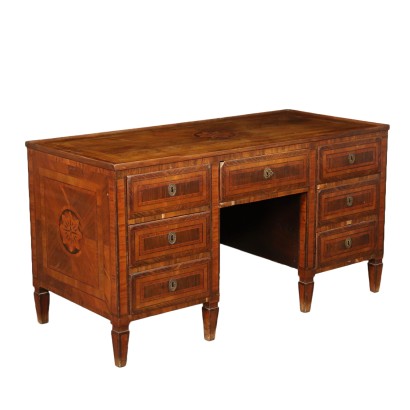Antique Neoclassical Desk with Drawers Italy 18th Century
Features
Style: Neo-Classical (1765-1790)
Age: 18th Century / 1701 - 1800
Origin: Italy
Main essence: Brazilian Rosewood , Olive
Material: Maple Slab , Walnut Slab , Rosewood Slab
Description
Elegant desk with pyramidal feet. Three drawers on each side and single drawer in the middle under the top. The front of the drawers is characterized by a succession of threads made of different woods. Surface, sides and front with large quadripartite reserve and central rosette with maple inlay. Top with embossed outline. Manufactured in Italy, last quarter of the 18th century.
Product Condition:
The item shows signs of wear due to age. Any damage or loss is displayed as completely as possible in the pictures. It may require restoration and recovery of french polish.
Dimensions (cm):
Height: 77,5
Width: 145,5
Depth: 65,5
Additional Information
Style: Neo-Classical (1765-1790)
This historical period includes a first phase that can be properly defined as the Louis XVI style.nOnly at a later time, with the maturation of archaeological fashions, was a new vision of furnishing civilization formulated and codified, now fully attributable to the Neoclassical Style.
In fact, both trends coexisted in unison until the last years of the eighteenth century.
nIn the field of cabinet making, the Directoire, Retour d'Egypte, Consular and Empire styles also fall within the neoclassical era.
nFind out more about Neoclassicism with the insights from our blog...
n































